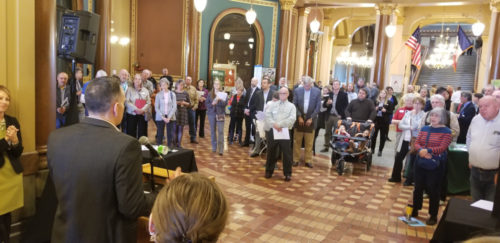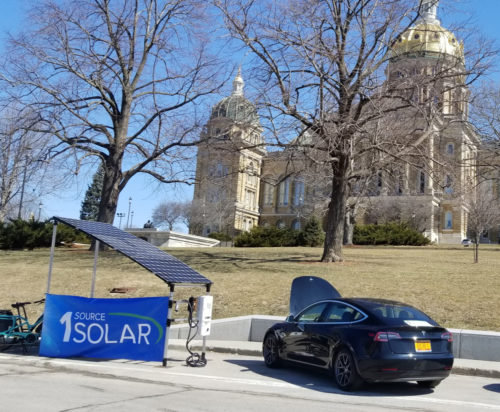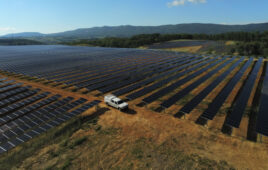Renewable energy policy starts on the coasts before slowly filtering to the middle of the country. While markets like California, Massachusetts and New Jersey are thriving, the Midwest is just now getting started. And with a booming market comes the reemergence of restrictive solar policies that more progressive states haven’t seen in years.
Many Midwest states are currently involved in battles between solar advocates and utility companies, with utilities citing the overused claim that residential solar customers aren’t helping to pay for the electric grid’s upkeep. So they’re passing demand charges and other damaging legislation that threaten to halt these emerging middle-of-the-country solar markets.
“[Solar is] literally seven-tenths of 1% of all electricity that [the utility in Iowa] produces. We don’t even exist to them, but their crystal ball does say that solar is going to grow by 30%,” said Todd Miller, president of 1 Source Solar, who spent most of 2019 in the Iowa State Capitol fighting proposed infrastructure fees for solar customers.
What does help overturn these restrictive policies is that presence in state legislative chambers, presenting stories and concerns to senators and representatives who are often just uninformed on how much the solar industry contributes to local economies. For many Midwest solar companies, taking on advocacy roles in an industry just getting off the ground has been a necessary responsibility.
“I never thought I’d be in a legislative chamber, but I do what I have to do,” said Kevin Good, president and owner of Good Energy Solutions of Kansas, a state embroiled in an ongoing battle against hefty demand charges.
Here is a look at solar policy in three Midwest states and how local solar installers have taken matters into their own hands.
Kansas: Still fighting
Two Kansas utilities, Westar Energy and KCP&L (both now owned by Evergy), were granted permission by the Kansas Corporation Commission in late 2018 to impose demand fees on solar customers. In Westar’s jurisdiction, any customer with solar panels installed after Oct. 2015 received a significant demand charge. KCP&L imposed the same demand fee, but only to customers who installed solar panels after the Sept. 2018 ruling.
The demand fee for the entire month was determined by the highest usage during peak hours of 2 to 7 p.m., Monday through Friday. Customers were charged $9/kW in the summer and $3/kW in cooler months. For example, if a customer’s peak demand was 10 kW on a Friday afternoon, they’d be charged $90 in the summer and $30 in off-months.
The demand charges went into effect immediately and with essentially no warning. Good Energy Solutions customers, some of whom had solar already for three years, started calling the company with questions.
“Depending on the home or the situation, that [demand charge] could take away half the value of a solar system to maybe the entire amount,” Good said. “The KCC just rubber stamped it. Not only did they pass it for anyone that installed after that date, but they went all the way back to 2015. That was the point we were mobilized. We had to make something happen.”
Good Energy Solutions quickly got involved with the Clean Energy Business Council to present a new bill to the Senate Utilities committee. The “Energy Fairness Act” aimed to revoke the demand charges and prohibit KCC from authorizing future damaging charges. Good felt it was important to talk with legislators because his livelihood was on the line. Once the demand charges went into effect, he said the residential solar market in Kansas came to a screeching halt.
“There is a lot of interest, but making a sale to someone who was going to get little value out of that system…it stopped the sale,” he said. “We had to look at the possibility to add batteries to even make it viable. It dried up the residential market in Kansas.”
Good Energy Solutions shifted focus to residential projects in Missouri and commercial deals in Kansas just to keep jobs rolling in, all while visiting the state capital and encouraging customers to call their legislators to bring an end to the extreme demand charges. Some of their concerns were met in March 2019 when Evergy agreed to grandfather Westar customers into old rates, but the high demand charges still stand for Kansas solar customers who installed after Sept. 2018.
Good said solar advocates have continued to meet with Evergy and the KCC to negotiate a better price for energy.
“It’s a chess game,” he said. Through it all, Good thinks it was important for Good Energy Solutions to be at the front lines of the fight.
“We took an active role once our old customers were getting damaged by what happened,” he said. “Our industry is just starting to hit its stride here. There aren’t many players and we have the opportunity to grow. We’re now one of the companies to help guide the industry.”
Ohio: Down but not out
This past summer, Ohio passed HB 6, lovingly called the “FirstEnergy bailout bill.” The legislation basically bails out two failing nuclear plants and two coal plants in the utility’s coverage area. From 2021 until 2027, every Ohio electricity customer will pay a monthly surcharge to subsidize the failing plants. In addition to the bailout, the bill stops energy-efficiency and renewable-energy mandates for all utilities. The current renewable mandates cost customers $4.75/month while the bailout fees will cost close to $1/month, so legislators passed the bill based on “saving ratepayers money.”
In a state fueled by cheap natural gas, a repeal on Ohio’s already fractured RPS makes solar less attractive than it once was, forcing many Ohio residential solar installers to look to states with more robust solar policies.
“The Ohio RPS has been weakened and diluted by fossil fuel interests for years, so the impact [of HB 6] is that this will continue,” said Geoff Greenfield, founder of Athens, Ohio-based Third Sun Solar. “This is a missed opportunity just to possibly improve customer economics.”
When Greenfield first learned of FirstEnergy’s bailout plan, he put out a request to Third Sun Solar customers to call and write their legislators. And although their concerns ultimately didn’t change the outcome, he doesn’t think the industry’s efforts were wasted.
“As frustrating as our current situation is, it is still our duty as citizens to participate in democracy with voting as well as advocacy,” Greenfield said. “Though I am cynical about the current state of politics, I believe in the old saying, ‘You can’t complain if you didn’t vote.’ I think this applies to advocacy as well. For me personally, it is a mission to accelerate the shift to clean energy, [and] this is part of that mission. As business owners creating jobs and improving the local economy, we have a great story to tell and our voices matter.”
Opponents of HB 6 are currently in a court battle over gathering signatures in an attempt to get a referendum on the November 2020 ballot. In the meantime, Third Sun Solar started an education campaign to express that residential solar in Ohio is not dead. Since the state has been weakening RPS requirements for years, future incentives for residential solar won’t be that far off what was previously offered. Third Sun Solar also states that with equipment pricing naturally declining, the price for solar in Ohio will continue to get lower.
Iowa: No news is good news
Investor-owned utilities in Iowa introduced a “sunshine tax” in early 2019, proposing a grid infrastructure fee to solar customers. Initially the proposed charge was $30/month, based on an average system size of 6 kW. The ambiguity around whether the charge would be $30 per customer or $30 per every 6 kW is what most concerned Miller of 1 Source Solar.
“We do a lot of work in the ag industry, putting solar on hog buildings,” he said. “If they were to put in a 60-kW system, does that mean their fee’s going to be $300?”
After the bill was first introduced, 1 Source Solar customers began calling the company daily, asking how to help fight it, so the company asked them to contact their legislators and travel to the capital to voice their concerns.
“It was a personal fight, taking those choices away from anybody to be able to add solar to their home, their business, their farm,” Miller said. “Our farmers are struggling, but solar gives them one option to be able to take control of a fixed expense. This bill really goes against our clients and their choice.”
While Iowa solar companies couldn’t compete with the utility’s advertisement and lobbying dollars, Miller said they tried their best to make some noise. Miller was a featured guest on local news programs and was interviewed by national news outlets.
“We spoke our passion about our clients and how it’s going to affect them. And we did this without calling out the names of the utilities,” he said. “I think our legislators appreciate that, and they appreciate speaking from the heart more than attacking. We’re the furthest thing from politicians, but we learned a lot this last session.”
The bill passed the Senate but was not brought up for a vote in the House. Out of session, solar advocates have been meeting with the utilities to work something out. The Iowa Solar Energy Trade Association has been assisting along the way.
Throughout this process, 1 Source Solar has seen its contracts decrease. At one point, the company put 13 jobs on hold because customers were too concerned about future charges. Miller said this is all unfortunate timing, since the Iowa solar market was just hitting its stride. After starting in 2015 with just two employees, 1 Source Solar has grown to 23 workers today, and Miller was expecting to double his workforce next year. But restrictive solar bills can halt growth. Legislators like to hear stories about employment and economic growth, and Miller is hoping continued advocacy moves the needle on any future decisions.
“We worked really hard to get solar in Iowa to where it is today. It seems like any teeny negative information is 10-times more harmful than one little positive piece. If something even gets brought up about extra fees for solar, everybody believes that there’s extra fees for solar. Then we have to spend six months educating people again saying it didn’t happen,” he said.
1 Source Solar is in it for the long haul. Headquartered so close to Des Moines, Miller said many of his employees quickly zip down to the statehouse when anything comes up. The company is now one of the most active pro-solar voices in the state, and that exposure will help business even in this slowdown.
“I didn’t think I’d be involved with politics, but it has helped our business tremendously just because we have been in the public eye,” Miller said. “I was in the Washington Post and had people calling from around the country to say, ‘Thank you. Fight the good fight.’ I was not thinking about that when we were fighting and our palms were sweaty and we were shaking, but now I feel like our programs are loaded and we’re ready to educate.”







“The demand fee for the entire month was determined by the highest usage during peak hours of 2 to 7 p.m., Monday through Friday. Customers were charged $9/kW in the summer and $3/kW in cooler months. For example, if a customer’s peak demand was 10 kW on a Friday afternoon, they’d be charged $90 in the summer and $30 in off-months.”
This and the rate spiking TOU programs becoming popular with electric utilities are the reasons to one’s own solar PV system with smart energy storage system. One can monitor the “flow” of power to and from the utility. A smart ESS with its own onboard hybrid inverter should be able to soften or eliminate these “peak demand charges”. A smart ESS should also be able to use the grid itself for arbitrage where off peak or super off peak electricity is used to charge the battery pack for the next days energy use. In the instance above, one could store most of the daily solar PV in the battery pack while using the (grid) power during the peak solar generation period of the day to run the house and sync up and use the stored battery power from the 2 to 7 PM hours when solar PV generation is “rolling off” for the day. At say midnight, if the utility has super off peak electricity pricing, charge the ESS battery for the next mornings “wake up” energy use time of day, just before solar PV starts to generate good usable power.